The sun had turned to orange early, filtered by the smoke of a nearby wildfire, and the dust of the two-track trail. All around, vast expanses of sage brush stretched to where nine thousand feet high ridges framed the scenery. The oppressive heat of the day still lingered, as our minds slowly started to shift from birds to the cool waters of the alpine lake ahead, and perhaps trout for dinner. Suddenly something stirred in the shrubs ahead. One bird head bobbed in the sea of grey-green leaves, shortly followed by a second. Sage grouse!
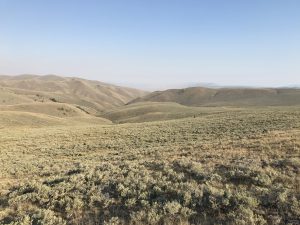
It all started with a spur-of-the-moment email to a friend in Butte.
“What do you know about sage grouse hunting in Montana?”
The response came quickly and oozed confidence: “I know everything about sage grouse hunting in Montana, my family has been hunting the opener for decades. We are going again this year. Why don’t you join us?”
Two days before the opener Finn, my seventeen-month-old Small Munsterlander, and I drove down, met up with my friend and his son, and set up camp the next day in time for a reconnaissance drive. Finn and I had chosen to stay in a tent. I like my privacy, and he would likely be too much puppy to allow for a quiet night in the trailer, with other people and other dogs. But mostly, I like my privacy.
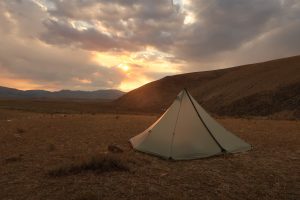
The nights at seven thousand feet were cold. Despite the daytime mid-thirties (Celsius) temperatures, nighttime temperatures straddled the freezing mark. Though that notion had crossed my mind, I had still brought a sleeping bag that could not be cinched up across the shoulders. Rookie mistake. Finn was comfortable, I think, in his kennel, with fluffy pillow, wearing a jacket. I was not.
We hunted the early mornings, to avoid overheating the dogs. Finn was running big, using the freedom the long views provided, casting nicely left and right, like he had been doing this for years. A few hours were all we had, before the dogs started to suffer. I fed Finn all his water and most of mine
but halfway through the mornings it was time to call it. The area had a surprising number of alpine lakes and shallow creeks, when everything around it was bone dry. Both dogs and hunters took advantage of the opportunity for a cool swim after the morning’s hunt. Late afternoons, with the sun losing just a hint of its sting, we would saddle up again, slowly driving and walking two-track rocky roads and field edges, trying to spot moving birds.
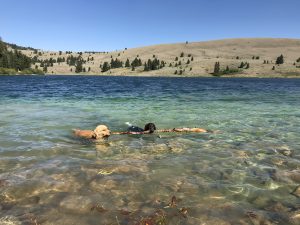 The choice of fields to hunt looked random to me, as for a mile in all directions the terrain was featureless, but it was based on years of experience in this area. I was beginning to pick up small clues about what sage grouse might like. Fresh greens, of which we saw little, grasshoppers, which were ubiquitous, just not in every field. Water perhaps? Some animals get their moisture from plants, but things were pretty arid here. I just imagined birds hitting up water early morning, working their way up to higher areas to catch a breeze, perhaps to return to water late afternoon, before retiring for the night in cover. But that was just speculation.
The choice of fields to hunt looked random to me, as for a mile in all directions the terrain was featureless, but it was based on years of experience in this area. I was beginning to pick up small clues about what sage grouse might like. Fresh greens, of which we saw little, grasshoppers, which were ubiquitous, just not in every field. Water perhaps? Some animals get their moisture from plants, but things were pretty arid here. I just imagined birds hitting up water early morning, working their way up to higher areas to catch a breeze, perhaps to return to water late afternoon, before retiring for the night in cover. But that was just speculation.
The first morning we flushed a single sage grouse, and two huns, which all escaped unscathed. Finn had not pointed any of the birds, but he had seen them fly, and had decided to abandon whatever steadiness we had so tenuously achieved in the pre-season prep. I could not fault him, because I had forgotten all my intentions to focus on the dog with the first few birds, and help him remember. The dog did not know better, I should have.
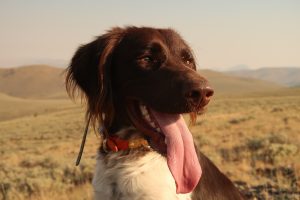
That evening we found the bobbing heads near a small water course and just off the two-track. I suggested falling back and around to get downwind of the birds and letting Finn work the breeze, but it was decided to follow the moving birds, taking the leashed dogs with us. As soon as we had stepped
across the water, Finn’s nose glued itself to the ground, the tail started working, and he became a handful. To my great surprise we managed to get within range before the first grouse flushed. The big bird worked hard to gain altitude, and the shot was not hard. Training a pup and hunting an elusive bird do not go well together. Both dogs rushed in for the retrieve but got distracted by two more falling birds, shot by my buddy. Each grabbed one of the fluttering birds and retrieved nicely, and my bird was found not too much later. A nice male bird, perhaps not the biggest, but not a young of the year either. We cut off wings for the registry, and took breasts and legs.
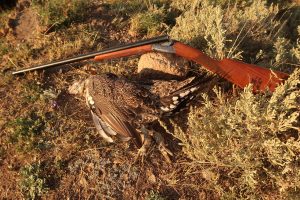 The second morning was mostly a repeat of the first. We hunted a large swath of land, in semi-circular fashion, above a small water source. My friend connected first, missing birds in a covey, but then connecting with the third shot on a single. Finn was bullied out of the retrieve by the other dog, but he got another chance. First a pair of grouse were bumped out of range by my friend’s dog, but not much later I shot a single with the second barrel, as it was rocketing down and around the slope. Finn nicely
The second morning was mostly a repeat of the first. We hunted a large swath of land, in semi-circular fashion, above a small water source. My friend connected first, missing birds in a covey, but then connecting with the third shot on a single. Finn was bullied out of the retrieve by the other dog, but he got another chance. First a pair of grouse were bumped out of range by my friend’s dog, but not much later I shot a single with the second barrel, as it was rocketing down and around the slope. Finn nicely
delivered to hand.
After a short, late-afternoon fishing session the next day, catching some cutthroats to add to the intended grouse dinner, we again found some birds. We tried to get organized, but waited too long and the grouse flushed. I followed them with Finn, on leash first, but as I got downwind, I let him run. The birds were in the open, and two grouse flushed out of range, but the third one hesitated, and once airborne, followed the downhill slope which curved towards me. I gave him a good two body lengths lead, and the bird crumbled at the shot. Another nice retrieve for Finn.
We investigated the crops of our birds and found they contained fresh leafy greens, and whitish, or light-yellow berries. We have yet to identify what those were. The fresh greens indicated that perhaps water courses, or the few fields that had not been grazed recently, were the preferred feeding areas this time of the year. But again, this is speculation, based on just a few observations.
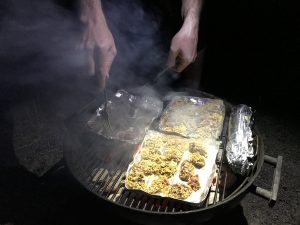 At night, my friend’s son cooked us up a nice meal of cubed, breaded grouse breast, and cutthroat trout. A few cold beers went with that, and life could not have been much better.
At night, my friend’s son cooked us up a nice meal of cubed, breaded grouse breast, and cutthroat trout. A few cold beers went with that, and life could not have been much better.